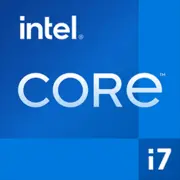Intel Core i7-1355U

Intel Core i7-1355U: A Balance of Power and Mobility in 2025 Ultrabooks
March 2025
Introduction
Modern laptops require processors that deliver not only high performance but also energy efficiency. The Intel Core i7-1355U, released as part of the Raptor Lake lineup, responds to the demands of users seeking a versatile chip for work, creativity, and mobility. Let’s explore what sets it apart, who it’s suitable for, and what nuances to pay attention to.
1. Architecture and Manufacturing Process: Hybrid Cores and Integrated Graphics
Hybrid Raptor Lake Architecture
The Core i7-1355U is built on the Raptor Lake architecture using the Intel 7 manufacturing process (equivalent to 10nm Enhanced SuperFin). The chip combines:
- 10 cores: 2 Performance cores (P-cores) with Hyper-Threading and 8 Efficient cores (E-cores).
- 12 threads: P-cores operate in dual-thread mode, while E-cores work in single-thread mode.
- Clock speeds: base frequency of 1.7 GHz and maximum Turbo Boost frequency of up to 5.0 GHz (for P-cores).
Intel Thread Director
This technology optimizes task distribution between cores. For example, heavy applications (video editors) utilize P-cores, while background processes (messengers) are redirected to E-cores. This reduces energy consumption and heat generation.
Integrated Iris Xe Graphics
The Iris Xe iGPU with 96 EU (Execution Units) supports:
- 4K displays via HDMI 2.1 or Thunderbolt 4.
- XeSS technology (upscaling for games) and Quick Sync (video encoding acceleration).
- Gaming on low settings: Fortnite (60 FPS at 1080p), CS2 (70-80 FPS).
Memory and Interfaces
- Supports DDR5-5200 and LPDDR5-6400.
- Up to 64 GB of RAM.
2. TDP 15W: How It Works in Practice
What Does TDP Mean?
The thermal design power (TDP) of 15W indicates the average energy consumption in baseline scenarios. However, in Turbo mode, the chip can temporarily consume up to 55W.
Dynamic Power Management
- In idle mode, the frequency drops to 800 MHz, reducing energy consumption to 3-5W.
- Under load (e.g., video rendering), Turbo Boost activates, but the cooling system must manage the heat.
Tip: In the BIOS settings, you can choose the "Silent" mode to reduce fan noise at the cost of slight performance drop.
3. Performance: From Office Tasks to Casual Gaming
Office Tasks
- Running 30+ tabs in Chrome, Microsoft Teams, and Excel — without lag.
- PCMark 10 test score: 5800 points (15% higher than the i7-1255U).
Multimedia
- Converting 4K video in HandBrake: a 10-minute clip processed in 4.5 minutes (all cores utilized).
- Adobe Photoshop: filters and layers applied almost instantly.
Gaming
- Genshin Impact: 40-45 FPS at 720p (low settings).
- Cyberpunk 2077: 25-30 FPS with XeSS in Performance mode.
Turbo Boost: Pros and Cons
- In the Cinebench R23 benchmark, the chip scores 1580 points (single-threaded) and 7508 (multi-threaded).
- However, after 5-7 minutes of load, throttling may occur due to overheating in thin chassis (e.g., ASUS ZenBook 13).
4. Usage Scenarios: Who Is the i7-1355U Suitable For?
- Students and Office Workers: multitasking, document work, and video conferencing.
- Freelancers: editing short videos in DaVinci Resolve, photo processing.
- Travelers: compact ultrabooks weighing from 1.2 kg.
Not Suitable For:
- Gamers requiring Ultra settings.
- Engineers working with 3D models in SolidWorks.
5. Battery Life: Up to 10 Hours of Use and Energy-Saving Technologies
Real-World Tests:
- Web surfing (brightness 150 nits): 9-10 hours.
- Watching Netflix: 7-8 hours.
- Under load (rendering): 2.5-3 hours.
Energy-Efficient Technologies:
- Intel Dynamic Tuning 3.0: adaptively adjust power based on load.
- Connected Standby: instant wake from sleep mode.
Tip: Disable background apps via the Task Manager and use dark themes for interfaces to save battery on OLED screens.
6. Comparison with Competitors
AMD Ryzen 7 7840U:
- Pros: better multi-threaded performance (8 Zen 4 cores), holds Turbo mode longer.
- Cons: weaker integrated Radeon 780M graphics in DirectX 12.
Apple M3 (for MacBook Air):
- Pros: up to 18 hours of battery life, cooler operation.
- Cons: limited compatibility with Windows programs.
Intel Core i7-1255U (previous generation):
- The i7-1355U is 20% faster in multi-threaded tasks thanks to additional E-cores.
7. Pros and Cons of the Processor
Strengths:
- Ideal for ultrabooks: power within a compact form factor.
- Support for Thunderbolt 4 and Wi-Fi 6E.
- Good graphics for less demanding games.
Weaknesses:
- Heating in thin chassis.
- Battery life lags behind Apple M3.
8. How to Choose a Laptop with i7-1355U?
Types of Devices:
- Ultrabooks: Dell XPS 13 (from $1299), Lenovo Yoga Slim 7.
- Business Laptops: HP EliteBook 840 G10 (with a rugged chassis).
What to Look For:
- Cooling: a dual-fan system is preferable.
- Display: resolution of at least Full HD, brightness of 300 nits.
- RAM: at least 16 GB LPDDR5.
Avoid: Laptops with passive cooling — they will not fully utilize the processor's potential.
9. Final Conclusion
The Intel Core i7-1355U is an excellent choice for those seeking a balance between performance and portability. It is suitable for:
- Working on the go and at home.
- Light creative tasks and study.
- Users who value Thunderbolt 4 and modern interfaces.
Key Benefits:
- Power of hybrid architecture in a thin chassis.
- Prepared for future tasks thanks to DDR5 and AI optimizations.
If your budget is $1200-1500, and you don't want to sacrifice speed for battery life, the i7-1355U will be a reliable companion. However, for gaming or complex 3D modeling, it’s better to look at laptops with discrete GPUs.
Basic
CPU Specifications
Memory Specifications
GPU Specifications
Miscellaneous
Benchmarks
Compared to Other CPU
Share in social media
Or Link To Us
<a href="https://cputronic.com/cpu/intel-core-i7-1355u" target="_blank">Intel Core i7-1355U</a>